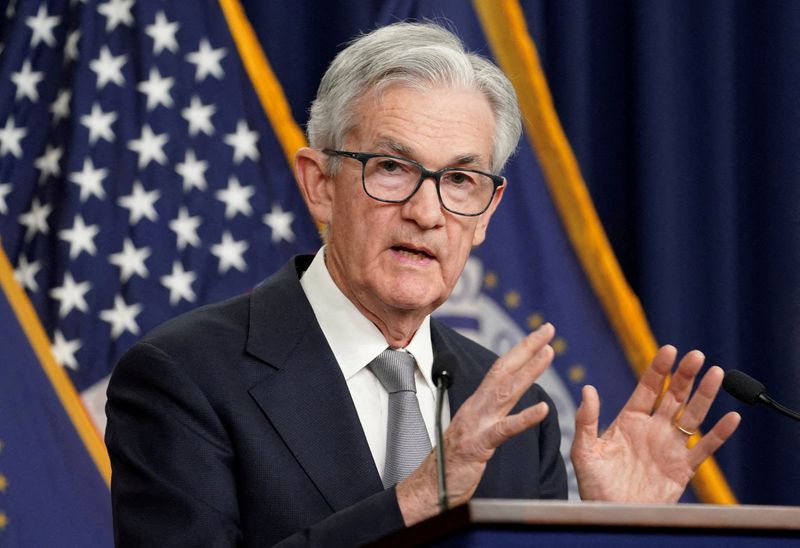
Fed’s Powell sees lower rates on the horizon as inflation ebbs, economy bounces ahead
© Reuters. FILE PHOTO: Federal Reserve Board Chair Jerome Powell answers a question at a press conference following a closed two-day meeting of the Federal Open Market Committee on interest rate policy at the Federal Reserve in Washington, U.S., November 1, 2023. RE
By Howard Schneider and Lindsay (NYSE:LNN) Dunsmuir
WASHINGTON (Reuters) – Federal Reserve Chair Jerome Powell, in a sweeping endorsement of the U.S. economy’s strength, said on Wednesday that interest rates had peaked and would move lower in coming months, with inflation continuing to fall and an expectation of sustained job and economic growth.
Powell, speaking after the end of a two-day policy meeting, declined to declare victory in the U.S. central bank’s two-year inflation fight, vouch that it had achieved a sought-after “soft landing” for the economy or promise that rate cuts would come as soon as the Fed’s March 19-20 meeting, as investors had hoped in the run-up to this week’s policy decision.
“Inflation is still too high. Ongoing progress in bringing it down is not assured,” Powell said after the Fed’s policy-setting committee kept the benchmark overnight interest rate in the 5.25%-5.50% range and announced that rate cuts would not be appropriate until there is “greater confidence that inflation is moving” towards the central bank’s 2% target.
But in almost every other way during a 48-minute session with reporters Powell offered an unhedged round of good news about the status of an aggressive war on inflation that many economists felt would tilt the U.S. into recession and throw millions out of work with the highest and fastest rate hikes in roughly 4 decades.
“The executive summary would be growth is solid to strong … 3.7% unemployment indicates the labor market is strong … We’ve got six good months of inflation data and an expectation that there’s more to come,” the Fed chief said. “Let’s be honest, this is a good economy.”
Powell said rate cuts would come once the Fed becomes more secure that inflation will continue to decline from a level it still characterizes as “elevated,” at least on a one-year basis, with the personal consumption expenditures price index, a key measure used by policymakers, at 2.6% on an annual basis as of December.
But he also suggested it was just a matter of time before that conviction kicks in.
Inflation is already below 2% when measured on a seven-month basis and the Fed has pledged rate cuts would begin before the one-year rate reaches the target level.
After Powell all but ruled out a cut at the March meeting, investors in contracts tied to the Fed’s policy rate keyed in on May 1 as the day the central bank will begin lowering that rate from the level it has held since last July.
While Powell’s comments lay out a rosy economic scenario in a presidential election year that could lean heavily on public attitudes about inflation and wages, they were nonetheless a short-term blow to investors who had been expecting rate cuts to start as early as seven weeks from now.
U.S. stocks fell after Powell’s comments and closed sharply lower on the day, while the dollar rose against a basket of currencies. U.S. Treasury yields also dropped.
“It is clear that the Fed are in no hurry to ease as rapidly as the market prices, with further promising inflation data still required in order to unlock the first rate reduction,” said Michael Brown, a market analyst at Pepperstone.
The outcome of the meeting also pushed back against calls from labor advocates for reductions in order to protect the current low unemployment rate at a time when some feel there may be developing weaknesses in the economy.
BANK, CREDIT RISKS DROPPED
Those risks were brought home on Wednesday when New York Community Bank announced an unexpected loss, an echo of banking troubles last spring that the Fed hopes have been put to rest. The latest policy statement from the central bank’s Federal Open Market Committee (FOMC), however, removed language, put in place following the failures in 2023 of Silicon Valley Bank and other lenders, that said the banking system is “sound and resilient” – a fact that in normal times would not need to be stated.
The Fed also dropped references to the uncertain impact of tight credit on households and businesses and the “lags” with which changes in monetary policy are felt in the economy, a hint that U.S. central bankers feel the current best-case outcome may endure absent some sort of unexpected shock.
Overall, the changes made to the policy statement codify what has been a developing Fed “pivot” that ends roughly two years in which the central bank’s bias has been towards moving rates higher and the risks seen as tilted towards those posed by escalating prices.
“Our policy rate is likely at its peak for this tightening cycle and that, if the economy evolves broadly as expected, it will likely be appropriate to begin dialing back policy restraint at some point this year,” Powell said.
Risks to the Fed’s dual employment and inflation goals “are moving into better balance,” the Fed’s policy statement said. “In considering any adjustments to the target range for the federal funds rate, the Committee will carefully assess incoming data, the evolving outlook, and the balance of risks.”
By contrast, the Fed’s prior statement, issued on Dec. 13, had laid out the conditions under which it would consider “any additional policy firming,” language that excluded any consideration of rate cuts.
Fed officials did not issue new economic projections at their meeting this week. As of the Dec. 12-13 meeting, policymakers envisioned cutting the policy rate by 75 basis points over the course of this year, an outlook that will be updated at the Fed’s meeting in March.
(This story has been refiled to fix punctuation in paragraph 5)
Terms And Conditions
Privacy Policy
Risk Warning
Do not sell my personal information
© 2007-2024 Fusion Media Limited. All Rights Reserved.
Risk Disclosure: Trading in financial instruments and/or cryptocurrencies involves high risks including the risk of losing some, or all, of your investment amount, and may not be suitable for all investors. Prices of cryptocurrencies are extremely volatile and may be affected by external factors such as financial, regulatory or political events. Trading on margin increases the financial risks.Before deciding to trade in financial instrument or cryptocurrencies you should be fully informed of the risks and costs associated with trading the financial markets, carefully consider your investment objectives, level of experience, and risk appetite, and seek professional advice where needed.Fusion Media would like to remind you that the data contained in this website is not necessarily real-time nor accurate. The data and prices on the website are not necessarily provided by any market or exchange, but may be provided by market makers, and so prices may not be accurate and may differ from the actual price at any given market, meaning prices are indicative and not appropriate for trading purposes. Fusion Media and any provider of the data contained in this website will not accept liability for any loss or damage as a result of your trading, or your reliance on the information contained within this website.It is prohibited to use, store, reproduce, display, modify, transmit or distribute the data contained in this website without the explicit prior written permission of Fusion Media and/or the data provider. All intellectual property rights are reserved by the providers and/or the exchange providing the data contained in this website.Fusion Media may be compensated by the advertisers that appear on the website, based on your interaction with the advertisements or advertisers.

